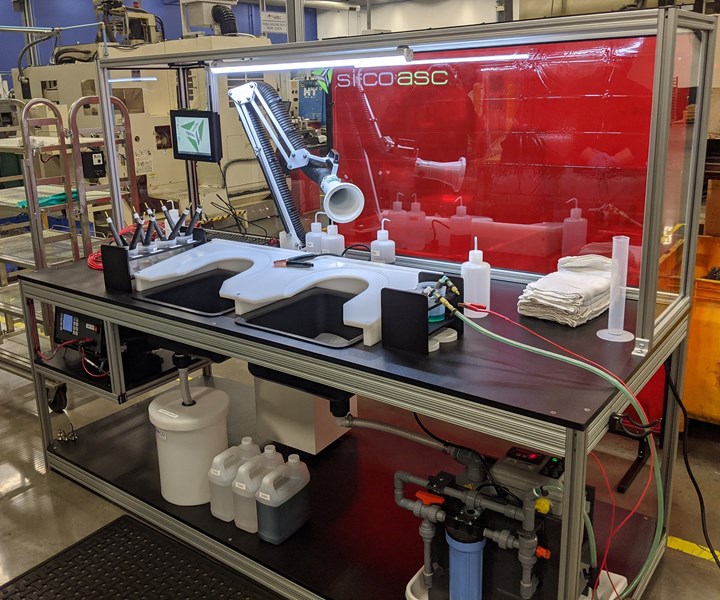Polamer Precision Incorporates Selective Plating Into Production Line
Global aerospace manufacturing company Polamer Precision, has worked with SIFCO ASC to bring a selective plating process in-house for improved output, lead time and quality control.

Source | SIFCO ASC
Polamer Precision (New Britain, Conn.), a global aerospace manufacturing company specializing in complex aerospace components for demanding applications, after working with SIFCO ASC (Independence, Ohio) on a plating application for an engine component for several years, has collaborated with SIFCO ASC’s engineers to bring the selective plating process in-house. Selective plating offers a method of electroplating localized areas without the use of an immersion tank.
“We worked with the team at Polamer Precision to specify and install a custom workstation, enabling them to incorporate the process into their own production line,” says Thomas Chapman, Northeast Sales Manager at SIFCO ASC.
The workstation tabletop sinks are constructed of heavy-duty, chemical-resistant high density polyethylene (HDPE), with holding fixtures made of ultra high molecular weight polyethylene and a polypropylene flow system tank. The full workstation measures 8 ft. wide by 3.4 ft. deep. The work surface is designed to accommodate auxiliary equipment, including SIFCO ASC’s AeroNikl Flow System. SIFCO ASC’s AeroNikl 250 plating is designed to be well-suited for brazing, a joining process common in the aerospace industry that joins parts using a molten filler material. Polamer chose AeroNikl 250 because it is a dense, highly pure sulfamate nickel deposit that is said to have excellent ductility, low stress and a high resistance to heat. The parts that Polamer processes are intricate and often include several braze joints per part, many of which may be located on small internal diameters. Because of the complexity of the plating areas, immersion plating presents too many challenges. With SIFCO ASC’s selective plating process and computer-aided process control workstation, which includes programmable control software, Polamer is able to target these complex, specific areas.
According to SIFCO ASC, the programmable control software allows Polamer Precision to monitor and control the process in two ways. First, it gives them the ability to passively monitor the process by manually adjusting the volts, amps and ampere hours. For tighter process control, the software also facilitates active programming of all steps, mitigating the likelihood of operator error.
SIFCO ASC’s process control tracking is unique in that, unlike bath plating, it monitors plating parameters per plating surface, allowing Polamer to collect process control data on a part-by-part basis and collect specific information on the surfaces on individual parts. Polamer says achieving this more granular level of data collection allows it to continually implement incremental improvements to its quality management program (QMP).
Other features of the workstation include a bus bar system for the preparatory tools. This feature prevents Polamer from having to disconnect and reconnect the leads and handles in between each process step, which is designed to save time. The plating tools are made out of titanium with a Dur-A-Form coating, allowing for extended use.
“By bringing our plating operation in-house, we’ve been able to double our output and reduce lead time by eliminating the need to ship products to an outside supplier,” says Derek Waszczuk, VP of Operations at Polamer Precision. “The system gives us complete ownership of the manufacturing and quality control process, from raw material through to delivery, allowing us to better serve our customers.”
Related Content
-
Multistage Wash System for Continuous Cleaning Efficiency
Gas-heated conveyor parts washing system is said to provide continuous, efficient cleaning throughout the multiple stages of the system.
-
Aerospace Conductive Coating Provides Adhesion, Fluid Resistance
Conductive coating (CM0485115) provides a high-conductivity solution for dissipating static on aluminum and composite aircraft.
-
Eliminating No-Value-Added Services Adds Value for Customers
Answering questions about how to best meet customer needs led this Products Finishing Top Shop to stop using trucks to provide value-added services and instead, start offering in-house solutions.












.jpg;maxWidth=300;quality=90)



